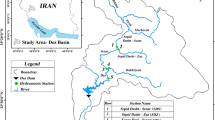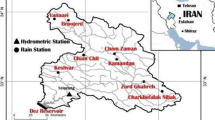Abstract
In this study, the river flow rate and suspended sediment load at Deh Molla hydrometric station in Zohreh River in the period of 1983–2018 were used for copula-based joint frequency. The Frank copula was selected as the best copula. The joint frequency analysis of the studied variables was performed based on the conditional density of the copula functions, which leads to the conditional occurrence probability of the variables. The results showed that with increasing river flow rate and suspended sediment load, the joint return period increases. Also, the joint return period for the "and" state is longer than the joint return period for the "or" state. When the river flow rate exceeds the threshold of 100 m3/s and suspended sediment load exceeds the threshold of 2.7 × 104 ton/day, the joint return periods for the "and" state and for the "or" state, are about 11 and 4 years, respectively.









Similar content being viewed by others
Abbreviations
- ICA:
-
Imperialist Competitive Algorithm
- GWO:
-
Gray Wolf Optimization Algorithm
- EA:
-
Election Algorithm
- RMSE:
-
Root Mean Square Error
- NSE:
-
Nash–Sutcliffe
- R 2 :
-
Coefficient of Determination
- SSC:
-
Suspended Sediment Concentration
- AR:
-
Autoregressive
- NRMSE:
-
Normalized Root Mean Square Error
- IFM:
-
Inference Functions for Margins
- Q w :
-
River flow rate (m3/s)
- Q s :
-
Suspended sediment load (ton/day)
- X m :
-
Measured data
- X p :
-
Predicted data
- \(\overline{X}_{m}\) :
-
Mean of the measured data
- \(\overline{X}_{p}\) :
-
Mean of the predicted data
- \(X_{{m_{\max } }}\) :
-
Maximum value of the measured data
- \(X_{{m_{{{\text{min}}}} }}\) :
-
Minimum value of the measured data
- F X(x):
-
Distribution of arbitrary margin of x
- F Y(y):
-
Distribution of arbitrary margin of y
- C :
-
Copula
- F X,Y(x, y):
-
Joint distribution function
- f Y(y):
-
Density functions of FY(y)
- f X(x):
-
Density functions of FX(x)
- Φ :
-
Generator function
- τ :
-
Kendall’s tau
- Ɵ :
-
Copula parameter
- \(\ln L_{C}\) :
-
Log likelihood function
- JRP:
-
Joint Return Period
- CP:
-
Conditional Probability
References
Abdous B, Genest C, Rémillard B (2004) Dependence properties of meta-elliptical distributions. In: Duchesne P, Rémillard B (eds) Statistical modeling and analysis for complex data problems. Kluwer, Dordrecht, pp 1–15
Ayantobo OO, Li Y, Song S, Javed T, Yao N (2018) Probabilistic modelling of drought events in China via 2-dimensional joint copula. J Hydrol 559:373–391
Bezak N, Mikos M, Sraj M (2014) Trivariate frequency analyses of peak discharge, hydrograph volume and suspended sediment concentration data using copulas. Water Resour Manage 28(8):2195–2212
Bezak N, Rusjan S, Kramar Fijavz M, Mikos M, Sraj M (2017) Estimation of suspended sediment loads using copula functions. Water 9(8):1–23
Blanco MLR, Castro MMT, Palleiro L, Castro MTT (2010) Temporal changes in suspended sediment transport in an Atlantic catchment, NW Spain. Geomorphology 123:181–188
Bushra N, Trepanier JC, Rohli RV (2019) Joint probability risk modelling of storm surge and cyclone wind along the coast of Bay of Bengal using a statistical copula. Int J Climatol 39(11):4206–4217
Capéraà P, Fougères AL, Genest C (2000) Bivariate distributions with given extreme value attractor. J Multivar Anal 72:30–49
Cech C (2006) Copula-based top-down approaches in financial risk aggregation. Available at SSRN 953888
Dastourani M, Nazeri Tahroudi M (2022) Toward coupling of groundwater drawdown and pumping time in a constant discharge. Appl Water Sci 12(4):1–13
De Michele C, Salvadori G (2003) A generalized Pareto intensity‐duration model of storm rainfall exploiting 2‐copulas. J Geophys Res Atmos, 108(D2)
Emami S, Parsa J (2021) Comparising performance of meta-heuristic algorithms with the sediment rate curve (case study: Zarrineh Rood River). J Watershed Eng Manag 13(1):43–54 ([In Persian])
Fang HB, Fang KT, Kotz S (2002) The meta-elliptical distributions with given marginals. J Multivar Anal 82:1–16
Favre AC, El Adlouni S, Perreault L, Thiemonge N, Bobee B (2004) Multivariate hydrologicalfrequency analysis using copulas. Water Resour Res 40(1):22–34
Forbes C, Evans M, Hastings N, Peacock B (2011) Statistical distributions. John Wiley & Sons, Hoboken
Genest C, Favre AC (2007) Everything you always wanted to know about copula modeling but were afraid to ask. J Hydrol Eng 12(4):347–368
Heng S, Suetsugi T (2013) Using artificial neural network to estimate sediment load in ungauged catchments of the Tonle Sap River Basin, Cambodia. J Water Resour Prot 5:111–123
Horowitz AJ (2003) An evaluation of sediment rating curves for estimating suspended sediment concentrations for subsequent flux calculations. Hydrol Process 17:3387–3409
Hui- Mean F, Yusof F, Yusop Z, Suhaila J (2019) Trivariate copula in drought analysis: a case study in peninsular Malaysia. Theoret Appl Climatol 138(1):657–671
Joe H (1997) Multivariate models and multivariate dependence concepts. Chapman & Hall, London, p 399
Keihani A, Akhondali AM, Fathian H (2021) Multivariate frequency analysis of peak discharge and suspended and bed sediment load in Karaj Basin, Iran. Water Resour Res 17(1):47–67 (in Persian)
Khashei-Siuki A, Shahidi A, Ramezani Y, Nazeri Tahroudi M (2021) Simulation of potential evapotranspiration values based on vine copula. Meteorol Appl 28(5):e2027
Laux P, Wagner S, Wagner A, Jacobeit J, Bardossy A, Kunstmann H (2009) Modelling daily precipitation features in the Volta Basin of West Africa. Int J Climatol 29(7):937–954
Li T, Wang S, Fu B, Feng X (2020) Frequency analyses of peak discharge and suspended sediment concentration in the United States. J Soils Sediments 20:1157–1168
Luo J (2011) Stepwise estimation of D-Vines with arbitrary specified copula pairs and EDA Tools
Luo Y, Dong Z, Liu Y, Zhong D, Jiang F, Wang X (2021) Safety design for water-carrying lake flood control based on copula function: a case study of the Hongze Lake, China. J Hydrol 597:126188
Miraboulghasemi H, Morid S (1997) Investigation of hydrological methods for estimating suspended load of rivers. J Water Dev 35:95–116 (in Persian)
Nash JE, Sutcliffe JV (1970) River flow forecasting through conceptual models part I—A discussion of principles. J Hydrol 10(3):282–290
Nazeri Tahroudi M, Ramezani Y, De Michele C, Mirabbasi R (2021) Multivariate analysis of rainfall and its deficiency signatures using vine copulas. Int J Climatol. https://doi.org/10.1002/joc.7349
Nazeri Tahroudi M, Ramezani Y, De Michele C, Mirabbasi R (2022) Trivariate joint frequency analysis of water resources deficiency signatures using vine copulas. Appl Water Sci 12(4):1–15
Nelsen RB (2006) An introduction to copulas, ser. Springer Science & Business Media
Peng Y, Shi Y, Yan H, Zhang J (2020) Multivariate frequency analysis of annual maxima suspended sediment concentrations and floods in the Jinsha River, China. J Hydrol Eng 25(9):05020029
Peng Y, Zhang J, Shi Y, Zhao X (2019) A copula-based method for stochastic simulation of daily suspended sediment concentration. J World Environ Water Resour Congr
Pham MT, Vernieuwe H, De Baets B, Willems P, Verhoest NE (2016) Stochastic simulation of precipitation-consistent daily reference evapotranspiration using vine copulas. Stoch Environ Res Risk Assess 30:2197–2214. https://doi.org/10.1007/s00477-015-1181-7
Reddy MJ, Ganguli P (2012) Bivariate flood frequency analysis of upper Godavari River flows using Archimedean copulas. Water Resour Manag 26(14):3995–4018
Salvadori G, De Michele C (2004) Analytical calculation of storm volume statistics involving Pareto‐like intensity‐duration marginals. Geophys Res Lett 31(4)
Salvadori G, De Michele C, Kottegoda NT, Rosso R (2007) Extremes in nature: an approach using copulas. Springer Science & Business Media, Dordrecht
Sandercock PA (2015) Short history of confidence intervals: or, don’t ask “does the treatment work?” but “how sure are you that it works?” Stroke 46(8):184–187
Shiau JT (2006) Fitting drought duration and severity with two-dimensional copulas. Water Resour Manag 20(5):795–815
Shiau JT, Lien YC (2021) Copula-based infilling methods for daily suspended sediment loads. Water 13(12):1701
Sklar A (1959) Fonctions de repartition and dimensions et leursmarges. Publications de L’Institute de Statistique. Universite’ De Paris 8:229–231
Tahroudi MN, Mirabbasi R, Ramezani Y, Ahmadi F (2022) Probabilistic assessment of monthly river flow discharge using copula and OSVR approaches. Water Resour Manag 36:2027–2043. https://doi.org/10.1007/s11269-022-03125-0
Tanim AH, Mullick RA, Sikdar S (2021) Evaluation of spatial rainfall products in sparsely gauged using copula uncertainty modeling with triple collocation. J Hydrol Eng 26 (4)
Wang X, Gebremichael M, Yan J (2010) Weighted likelihood copula modeling of extreme rainfall events in Connecticut. J Hydrol 390(1–2):108–115
Wong G, Lambert MF, Leonard M, Metcalfe AV (2010) Drought analysis using trivariate copulas conditional on climatic states. J Hydrol Eng 15(2):129–141
Xu W, Hou Y, Hung Y, Zou Y (2010) Comparison of Spearman’s rho and Kendall’s tau in Normal and Contaminated Normal Models. Signal Process. https://doi.org/10.1016/j.sigpro.2012.08.005
Yue S, Rasmussen P (2002) Bivariate frequency analysis: discussion of some useful concepts in hydrological application. J Hydrol Process 16(4):2881–2889
Zhong M, Wang J, Jiang T, Huang Z, Chen X, Hong Y (2020) Using the apriori algorithm and copula function for the bivariate analysis of flash flood risk. Water. https://doi.org/10.3390/w12082223
Acknowledgements
The authors would like to thank Khuzestan Water and Power Authority (KWPA) for providing the data.
Funding
The authors declare that no funds, grants, or other support were received during the preparation of this manuscript.
Author information
Authors and Affiliations
Corresponding author
Ethics declarations
Conflict of interest
The authors declare that they have no known competing financial interests or personal relationships that could have appeared to influence the work reported in this paper.
Additional information
Edited by Dr. Ankit Garg (ASSOCIATE EDITOR) / Dr. Michael Nones (CO-EDITOR-IN-CHIEF).
Rights and permissions
Springer Nature or its licensor holds exclusive rights to this article under a publishing agreement with the author(s) or other rightsholder(s); author self-archiving of the accepted manuscript version of this article is solely governed by the terms of such publishing agreement and applicable law.
About this article
Cite this article
Pronoos Sedighi, M., Ramezani, Y., Nazeri Tahroudi, M. et al. Joint frequency analysis of river flow rate and suspended sediment load using conditional density of copula functions. Acta Geophys. 71, 489–501 (2023). https://doi.org/10.1007/s11600-022-00894-5
Received:
Accepted:
Published:
Issue Date:
DOI: https://doi.org/10.1007/s11600-022-00894-5




